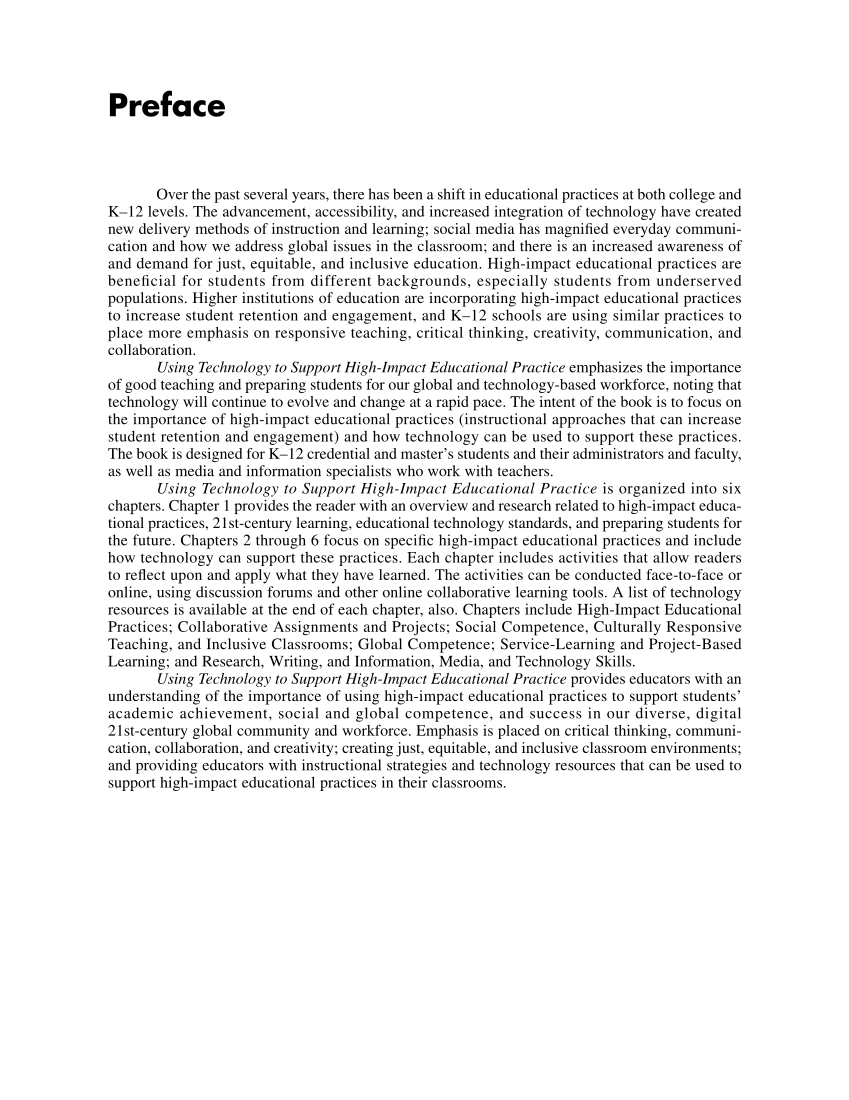Preface Over the past several years, there has been a shift in educational practices at both college and K–12 levels. The advancement, accessibility, and increased integration of technology have created new delivery methods of instruction and learning social media has magnified everyday communi- cation and how we address global issues in the classroom and there is an increased awareness of and demand for just, equitable, and inclusive education. High-impact educational practices are beneficial for students from different backgrounds, especially students from underserved populations. Higher institutions of education are incorporating high-impact educational practices to increase student retention and engagement, and K–12 schools are using similar practices to place more emphasis on responsive teaching, critical thinking, creativity, communication, and collaboration. Using Technology to Support High-Impact Educational Practice emphasizes the importance of good teaching and preparing students for our global and technology-based workforce, noting that technology will continue to evolve and change at a rapid pace. The intent of the book is to focus on the importance of high-impact educational practices (instructional approaches that can increase student retention and engagement) and how technology can be used to support these practices. The book is designed for K–12 credential and master’s students and their administrators and faculty, as well as media and information specialists who work with teachers. Using Technology to Support High-Impact Educational Practice is organized into six chapters. Chapter 1 provides the reader with an overview and research related to high-impact educa- tional practices, 21st-century learning, educational technology standards, and preparing students for the future. Chapters 2 through 6 focus on specific high-impact educational practices and include how technology can support these practices. Each chapter includes activities that allow readers to reflect upon and apply what they have learned. The activities can be conducted face-to-face or online, using discussion forums and other online collaborative learning tools. A list of technology resources is available at the end of each chapter, also. Chapters include High-Impact Educational Practices Collaborative Assignments and Projects Social Competence, Culturally Responsive Teaching, and Inclusive Classrooms Global Competence Service-Learning and Project-Based Learning and Research, Writing, and Information, Media, and Technology Skills. Using Technology to Support High-Impact Educational Practice provides educators with an understanding of the importance of using high-impact educational practices to support students’ academic achievement, social and global competence, and success in our diverse, digital 21st-century global community and workforce. Emphasis is placed on critical thinking, communi- cation, collaboration, and creativity creating just, equitable, and inclusive classroom environments and providing educators with instructional strategies and technology resources that can be used to support high-impact educational practices in their classrooms.
Document Details My Account Print multiple pages
Print
You have printed 0 times in the last 24 hours.
Your print count will reset on at .
You may print 0 more time(s) before then.
You may print a maximum of 0 pages at a time.













































































































































































